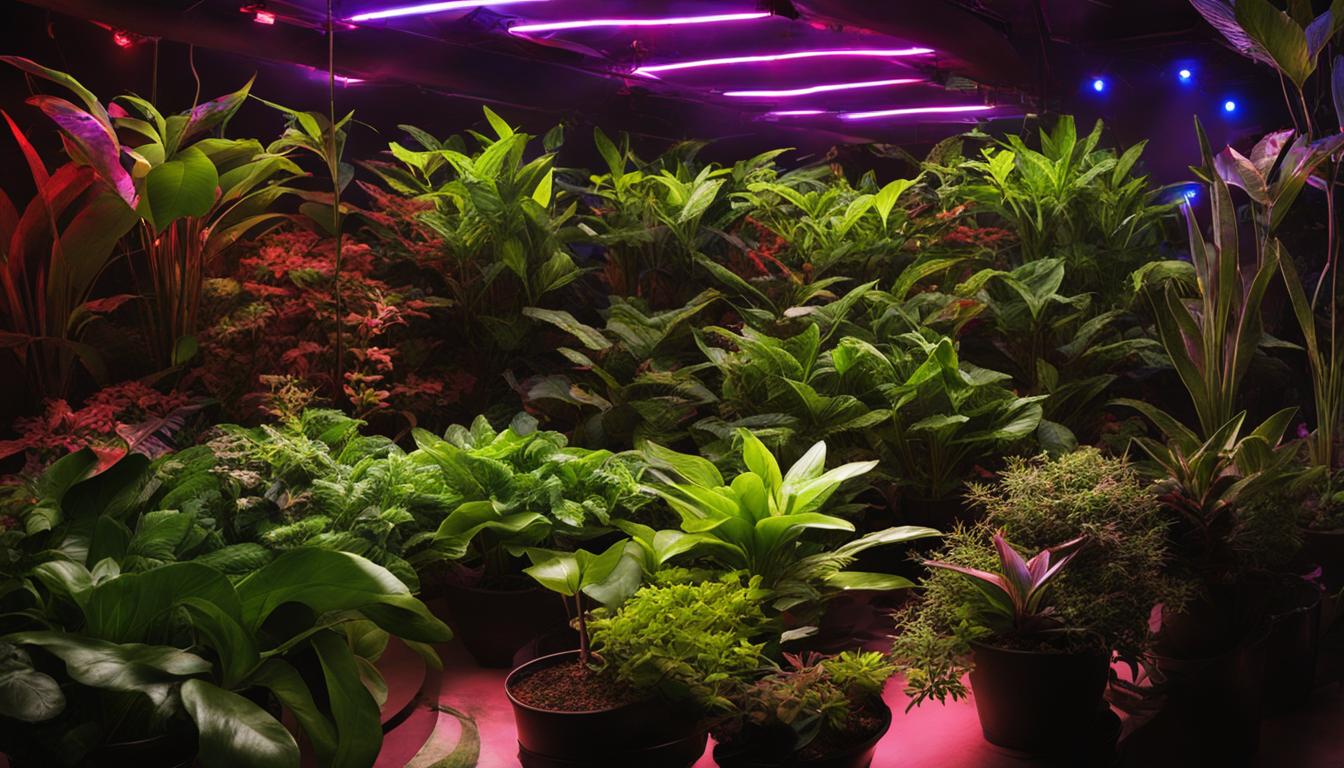
LED grow lights are revolutionizing indoor gardening by providing a reliable and energy-efficient solution for year-round plant care.
With their ability to provide the necessary light spectrum for healthy growth, LED lights have become an indispensable tool for indoor gardeners.
In this article, I will guide you on how to effectively use LED lights for your indoor plants, ensuring optimal growth and a thriving indoor garden.
Indoor plant care with LED lights offers several advantages over traditional lighting systems. LED lights are energy-efficient, durable, and safe to use.
They can supplement natural sunlight, providing plants with the light they need to thrive indoors. By understanding the light spectrum and choosing the right LED lights, you can maximize plant growth and achieve the best results.
Let’s delve deeper into the world of LED indoor plant lighting and discover how to make the most of this technology for your indoor garden.
Key Takeaways:
- LED grow lights offer a reliable and energy-efficient solution for year-round indoor gardening
- LED lights provide the necessary light spectrum for photosynthesis and specific growth stages
- Proper placement and timing of LED grow lights are crucial for optimal plant growth
- LED lights are durable, safe to use, and can be used to supplement natural sunlight
- By understanding the light spectrum and adjusting LED lights, you can maximize plant growth
Understanding the Light Spectrum for Plant Growth
When it comes to indoor gardening with LED lights, understanding the light spectrum is key to promoting healthy plant growth. Sunlight contains a range of colors that plants use for photosynthesis, but not all colors are equally crucial.
Plants absorb more red and blue light, which are essential for stimulating vegetative growth, flowering, and fruit production. While green and yellow light also play a role in photosynthesis, they are not as critical as the red and blue wavelengths.
For optimal plant growth using LED lights, it is important to provide adequate light in the red and blue spectrum. Red light in the range of 640 to 680 nanometers stimulates flowering and fruit production, while blue light in the 430 to 450 nanometer range is crucial for seedling development and strong roots.
By focusing on these specific wavelengths, LED grow lights can provide plants with the light they need to thrive indoors.
| Light Spectrum | Plant Growth Stage | LED Light Color |
|---|---|---|
| 430 – 450 nanometers | Seedling development, root growth | Blue |
| 640 – 680 nanometers | Flowering, fruit production | Red |
In addition to red and blue light, other colors can also have a positive impact on plant growth. UV light, for example, can enhance the yield and flavor of certain herbs, while infrared light plays a role in plant development.
By considering the different wavelengths and their effects on plants, indoor gardeners can tailor their LED lighting setups to meet the specific needs of their plants at different stages of growth.
Advantages of Using LED Grow Lights
LED grow lights offer several benefits that make them a superior choice for indoor plant care. One of the primary advantages is their energy efficiency.
LED lights use 75% less electricity than traditional incandescent lights, resulting in significant cost savings. Additionally, the reduced energy consumption also contributes to a lower carbon footprint, making LED lights an environmentally-friendly option.
Another key advantage of LED grow lights is their durability. These lights can last up to 50,000 hours of use, providing a long-lasting solution for indoor gardening.
Unlike other types of lights that require frequent replacement, LED lights offer a reliable and low-maintenance option.
LED grow lights also emit less heat compared to traditional lighting systems. This not only helps in preventing damage to plants but also reduces the risk of fire. The cooler operating temperature of LED lights eliminates the need for excessive cooling systems, further enhancing energy efficiency.
Advantages of Using LED Grow Lights:
- Energy-efficient: LED lights use 75% less electricity than traditional lights, resulting in cost savings and a reduced carbon footprint.
- Durable: LED grow lights can last up to 50,000 hours of use, providing a long-lasting and low-maintenance solution for indoor gardening.
- Reduced Heat Emission: LED lights emit less heat, preventing damage to plants and reducing the risk of fire. This also eliminates the need for excessive cooling systems.
Overall, LED grow lights offer a range of advantages for indoor plant care. Their energy efficiency, durability, and reduced heat emission make them a cost-effective and safe choice for cultivating healthy and thriving plants.
Choosing the Right LED Grow Lights
When it comes to indoor gardening with LED lights, choosing the right type of LED grow lights is crucial for the success of your plants. There are various options available, but the two main types to consider are full-spectrum LED grow lights and adjustable LED grow lights.
Full-Spectrum LED Grow Lights
Full-spectrum LED grow lights are designed to provide a complete light spectrum that mimics natural sunlight. They emit a wide range of wavelengths, including red, blue, green, and even ultraviolet and infrared light.
These lights are ideal for plants throughout all stages of their growth cycle, from seedlings to flowering and fruiting. Full-spectrum LED grow lights ensure that your plants receive all the light they need for optimal growth and development.
Adjustable LED Grow Lights
If you want more control over the light spectrum for specific growth stages, adjustable LED grow lights are a great option. These lights allow you to customize the intensity and color output of the LEDs.
By adjusting the light colors, you can promote vegetative growth with blue light and stimulate flowering and fruit production with red light. Adjustable LED grow lights give you the flexibility to cater to the specific needs of your plants at different stages of their growth.
| Type of LED Grow Lights | Advantages |
|---|---|
| Full-Spectrum LED Grow Lights | Provide a complete light spectrum for all growth stages, mimicking natural sunlight |
| Adjustable LED Grow Lights | Offer customization of light intensity and color output, allowing for targeted growth stimulation |
When deciding between full-spectrum and adjustable LED grow lights, consider the specific needs of your plants and your gardening goals. Full-spectrum LED grow lights are a versatile choice that caters to a wide range of plants, while adjustable LED grow lights give you more control and flexibility.
Whichever type you choose, LED grow lights offer energy efficiency, longevity, and safety for your indoor gardening needs.
Using LED Lights for Seedlings and Vegetative Growth
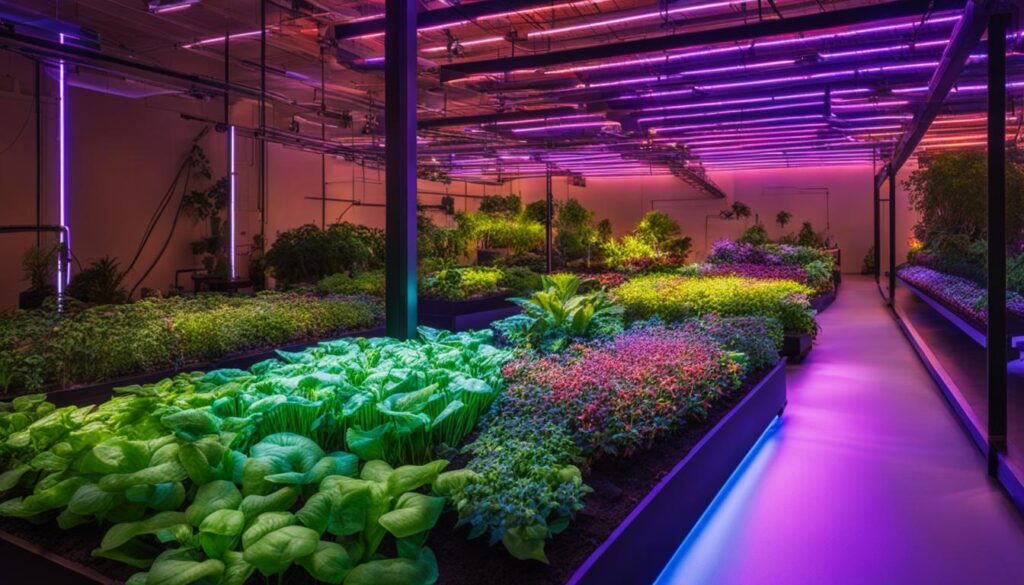
LED grow lights are a fantastic option for starting seedlings and promoting healthy vegetative growth in plants. These lights emit a blue light in the 430 to 450 nanometer range, which is crucial for seedling development and the growth of strong roots.
By providing the right light spectrum, LED lights ensure that your seedlings receive the necessary light energy for optimal growth indoors.
In combination with natural sunlight, LED grow lights can be used to create the perfect lighting environment for your seedlings. It is recommended to provide 12 to 14 hours of light per day to promote vigorous growth.
But, it’s important to give your plants a rest period to recuperate. This can be achieved by using LED light timers to automate the lighting schedule, ensuring consistent and appropriate light exposure.
With LED lights, you have control over the growth of your plants. By adjusting the distance between the LED lights and the seedlings, you can customize the light intensity and prevent any potential damage.
LED lights emit less heat compared to traditional lighting systems, allowing you to place them closer to your plants without the risk of burning them.
Comparing LED Light Timers
| Timer Model | Features | Price Range |
|---|---|---|
| Model A | 24-hour programmable timer with customizable on/off cycles for precise control | $10 – $20 |
| Model B | Digital timer with built-in light sensor for automatic day and night cycle simulation | $15 – $25 |
| Model C | Wi-Fi enabled timer with smartphone app control and advanced scheduling options | $30 – $50 |
When selecting an LED light timer, consider the features that best suit your needs and budget. Whether it’s a basic programmable timer or a more advanced Wi-Fi enabled model, having a timer will ensure that your seedlings receive consistent and appropriate lighting, promoting healthy growth and development.
With LED lights and the right lighting schedule, you can give your seedlings the best possible start and set them on a path to thriving growth.
The customizable nature of LED lights, combined with the use of light timers, allows you to provide the optimal light spectrum and timing for your plants’ specific needs. Enjoy the benefits of using LED lights for seedlings and witness the remarkable growth and development of your indoor garden.
Using LED Lights for Flowering and Fruit Production
When it comes to flowering and fruit production in plants, LED lights play a crucial role. The red spectrum of LED lights, particularly between 640 and 680 nanometers, stimulates the process of flowering and encourages the production of fruits. By adjusting the LED colors, you can effectively promote specific growth stages in your plants.
During the vegetative growth stage, blue light is essential for promoting strong and healthy foliage. It encourages the development of robust leaves and stems, setting the foundation for a successful flowering phase.
As your plants transition into the reproductive phase, switching to red light becomes important to trigger the production of flowers and fruits.
LED grow lights with adjustable colors are highly recommended for indoor gardeners who want to provide the ideal light spectrum throughout the plant’s lifecycle.
By customizing the light colors and wavelengths, you can achieve optimal results and maximize the potential of your plants.
Promoting Flowering and Fruit Production with LED Lights
LED lights offer flexibility and precision in adjusting the light spectrum for flowering and fruit production. With the ability to fine-tune the colors emitted by your LED grow lights, you can create the perfect environment for your plants to thrive.
| Growth Stage | Recommended LED Light Colors |
|---|---|
| Vegetative Growth | Blue light (430-450nm) |
| Flowering and Fruit Production | Red light (640-680nm) |
By providing your plants with the appropriate light spectrum for each stage, you can ensure optimal growth, flowering, and fruiting. LED lights give you the power to simulate natural sunlight and create the ideal conditions for your indoor garden.
Now that we’ve explored the importance of LED lights for flowering and fruit production, we can move on to understanding the proper placement and timing of LED grow lights in section 7.
Proper Placement and Timing of LED Grow Lights
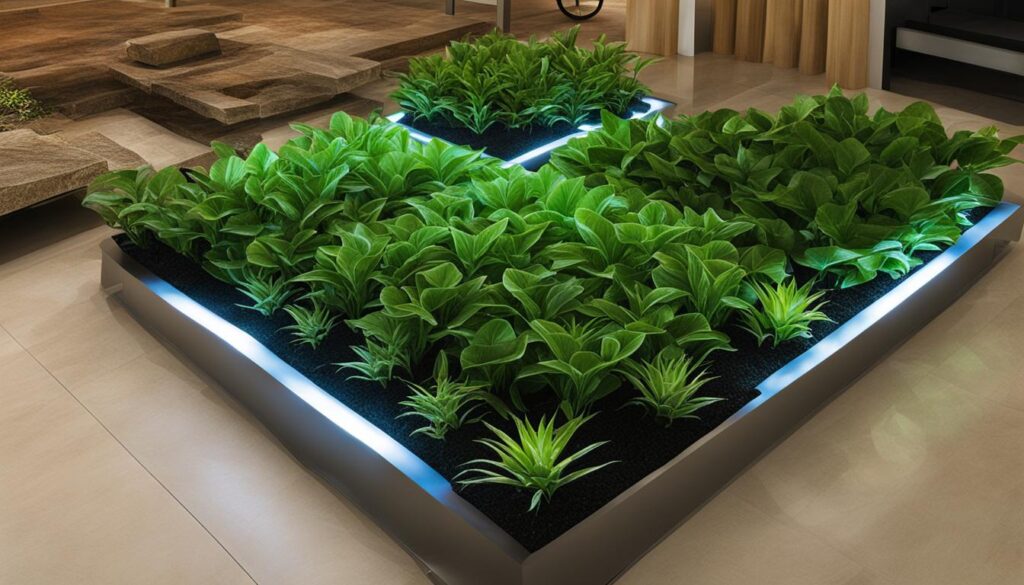
When it comes to maximizing the benefits of LED grow lights for indoor plants, proper placement and timing are crucial factors to consider. By understanding the optimal distance between the lights and the plants, as well as the ideal timing of light exposure, you can ensure the best results for your indoor garden.
LED grow lights emit less heat compared to traditional lighting systems, allowing you to place them closer to your plants without the risk of heat damage.
It is recommended to position the lights between 14 to 30 inches above the plants, depending on their growth stage and light requirements. This close proximity ensures that the plants receive sufficient light intensity for photosynthesis while preventing any potential light burn.
In terms of timing, it is important to provide your plants with an appropriate amount of light per day. While each plant species may have specific light requirements, a general guideline is to provide at least 12 hours of light per day.
This mimics the natural daylight cycle and promotes healthy growth. However, it is equally important to allow for a period of darkness, typically between 8 to 12 hours, to give your plants time to rest and recover. This balance between light and dark helps to avoid overexposure and allows for optimal plant development.
The Importance of Light Exposure Timing
By using timers, you can easily regulate the timing of LED light exposure for your indoor garden. Timers allow you to set a consistent lighting schedule, ensuring that your plants receive the right amount of light at the right time. This not only provides convenience but also helps to maintain a stable environment for your plants.
When setting up your lighting schedule, consider the specific needs of your plants during different growth stages. Seedlings and young plants may require longer periods of light exposure, ranging from 14 to 18 hours per day, to promote vigorous growth.
As the plants enter the vegetative stage, 12 to 14 hours of light is usually sufficient. During the flowering and fruiting stage, you may want to reduce the light exposure to 10 to 12 hours per day to stimulate flower and fruit production.
Remember to regularly monitor your plants and adjust the distance and timing of your LED grow lights as needed. Each plant has its own unique requirements, and observing their response to the light will help you fine-tune your indoor gardening setup for optimal results.
| Plant Growth Stage | Recommended Light Exposure |
|---|---|
| Seedling Stage | 14 to 18 hours per day |
| Vegetative Stage | 12 to 14 hours per day |
| Flowering and Fruiting Stage | 10 to 12 hours per day |
Growing Indoor Plants with LED Lights Year-Round
LED grow lights offer numerous benefits for year-round indoor gardening, allowing plant enthusiasts to cultivate plants regardless of the season. By providing the necessary light spectrum, LED lights ensure optimal plant growth and health throughout the year.
One significant advantage of using LED lights for year-round plant growth is the ability to control the light spectrum. LED lights can be customized to emit specific wavelengths of light, such as red and blue, which are essential for different growth stages.
Furthermore, LED grow lights are energy-efficient, consuming significantly less electricity compared to traditional lighting systems.
This not only saves on energy costs but also reduces the environmental impact. LED lights also emit less heat, minimizing the risk of damage to plants and eliminating the need for excessive cooling systems.
With LED grow lights, indoor gardeners can create the ideal environment for their plants while minimizing energy consumption.
Indoor gardening with LED lights enables plant enthusiasts to enjoy a continuous supply of fresh produce all year round. Whether growing vegetables, herbs, or flowers, LED lights provide the necessary light spectrum to support healthy growth and harvests.
With careful adjustment of light intensity and duration, plants can thrive and produce high-quality yields indoors. LED grow lights offer a cost-effective and efficient solution for year-round indoor gardening, making it accessible to plant enthusiasts of all levels of experience.
| Benefits of Year-Round Indoor Gardening with LED Lights |
|---|
| 1. Ability to control the light spectrum for different growth stages |
| 2. Energy-efficient, reducing energy costs and environmental impact |
| 3. Minimal heat emission, reducing the risk of plant damage |
| 4. Continuous supply of fresh produce regardless of the season |
| 5. Suitable for growing a variety of plants, including vegetables, herbs, and flowers |
Overall, LED grow lights provide the tools necessary for successful year-round indoor gardening. With their customizable light spectrum, energy efficiency, and ability to support plant growth throughout the year, LED lights are an excellent choice for plant enthusiasts looking to cultivate a thriving indoor garden.
Maximizing Plant Growth with LED Lights
When it comes to indoor plant care, LED grow lights offer a range of benefits that can help maximize plant growth.
By optimizing the use of LED lights, indoor gardeners can provide their plants with the optimal light spectrum for photosynthesis and specific growth stages. This ensures that plants receive the necessary light and energy to thrive indoors.
One way to maximize plant growth with LED lights is by adjusting the distance between the lights and the plants. LED lights emit less heat compared to traditional lighting systems, allowing them to be placed closer to the plants without causing damage.
By positioning the lights within the recommended range of 14 to 30 inches above the plants, you can provide the plants with the ideal light intensity and coverage.
Another key factor in maximizing plant growth is by adjusting the light colors. Different colors of light have varying effects on plant growth and development.
Blue light, for example, is crucial for vegetative growth, while red light stimulates flowering and fruit production. LED grow lights with adjustable colors provide the flexibility to customize the light spectrum based on the specific growth stage of the plants.
By providing the right combination of red and blue light, you can optimize plant growth and maximize indoor plant care.
Comparing Plant Growth Factors with LED Lights
| Factors | Traditional Lighting | LED Grow Lights |
|---|---|---|
| Energy Efficiency | Consumes more electricity | Uses 75% less electricity |
| Heat Emission | Emits more heat, requiring cooling systems | Emits less heat, reducing strain on cooling systems |
| Lifespan | Shorter lifespan | Lasts up to 50,000 hours |
| Light Spectrum | May not provide optimal spectrum for plants | Customizable spectrum for different growth stages |
By understanding the light spectrum, adjusting the distance between LED lights and plants, and customizing the light colors, you can maximize plant growth with LED lights.
These energy-efficient and versatile lighting solutions provide the control and flexibility needed to ensure that your indoor plants receive the best care possible.
Whether you’re growing seedlings or promoting flowering, LED grow lights can help you achieve impressive results and maintain thriving plants year-round.
Conclusion: Enjoy Year-Round Indoor Gardening with LED Lights
I have discussed the numerous benefits of using LED grow lights for indoor gardening throughout this article. With LED lights, you can enjoy year-round indoor gardening regardless of the season.
The advantages of LED lights, such as their energy efficiency and durability, make them an excellent choice for indoor plant care.
One of the key benefits of indoor gardening with LED lights is the ability to provide plants with the necessary light spectrum for healthy growth. LED lights emit the right wavelengths of light, including red and blue, which are crucial for photosynthesis and stimulating plant growth. By using LED grow lights, you can optimize plant growth and achieve the best results.
Indoor gardening with LED lights also allows for flexibility and control. You can adjust the distance between the lights and your plants to ensure optimal light exposure. Additionally, LED lights with adjustable colors enable you to customize the light spectrum based on the specific growth stage of your plants.
Furthermore, LED grow lights are a cost-effective and efficient solution for indoor plant care. Their long lifespan and energy efficiency make them a sustainable choice, saving you money on electricity bills.
By investing in LED lights, you can cultivate a continuous supply of fresh produce and enjoy the benefits of a thriving indoor garden all year round.
FAQ
How do LED lights benefit indoor plant care?
LED lights provide the necessary light spectrum for photosynthesis, allowing plants to thrive indoors. They are energy-efficient, durable, and safe to use.
What light spectrum is important for plant growth?
Plants absorb more light in the red and blue spectrum, which is crucial for vegetative growth, flowering, and fruit production. Green and yellow light are also used for photosynthesis.
What are the advantages of using LED grow lights?
LED grow lights are extremely durable, energy-efficient, and emit less heat. They are a cost-effective and long-lasting solution for indoor plant care.
What types of LED grow lights are available?
There are incandescent, fluorescent, LED, and high-intensity discharge (HID) lights. LED grow lights are the most versatile and suitable for small-scale applications.
How can LED lights be used for seedlings and vegetative growth?
Blue light in the 430 to 450 nanometer range is crucial for seedling development and strong roots. LED lights can be used in combination with natural sunlight, and timers can be used to automate the lighting schedule.
How can LED lights be used for flowering and fruit production?
LED lights in the red spectrum, particularly between 640 and 680 nanometers, stimulate flowering and fruit production. Adjusting LED colors can promote specific growth stages.
How should LED grow lights be placed and timed?
LED grow lights should be placed 14 to 30 inches above the plants. It is important to provide plants with at least 12 hours of light per day, with a rest period for darkness. Timers can regulate light exposure.
Can LED lights be used for year-round indoor gardening?
Yes, LED lights provide the necessary light spectrum for year-round indoor gardening, ensuring a continuous supply of fresh produce regardless of the season.
How can LED lights maximize plant growth?
By understanding the light spectrum and using the right LED lights, plants can receive optimal light for photosynthesis and specific growth stages. Adjustable LED lights offer flexibility and control.
How do LED grow lights benefit indoor gardeners?
LED grow lights revolutionize indoor gardening with their reliability, energy-efficiency, and long lifespan. They provide the necessary light spectrum for healthy plant growth and are ideal for year-round plant care.

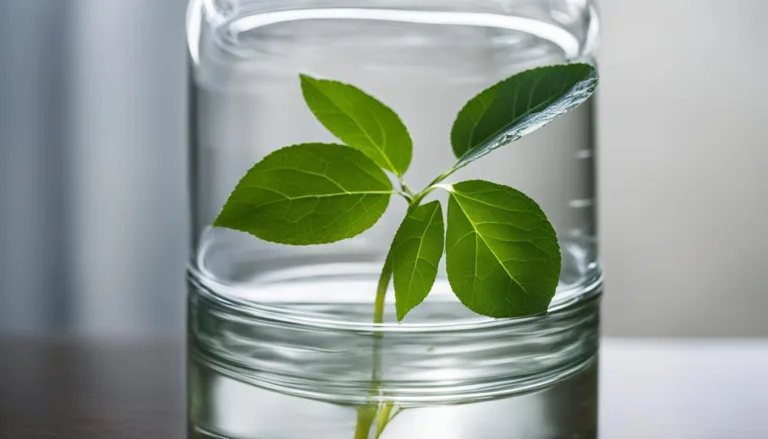
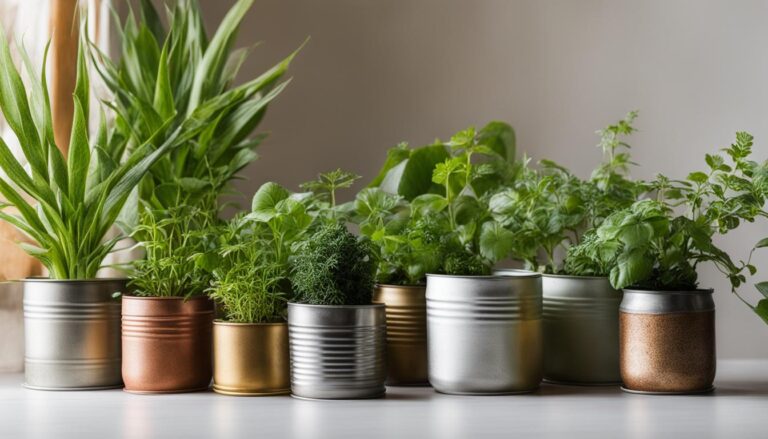
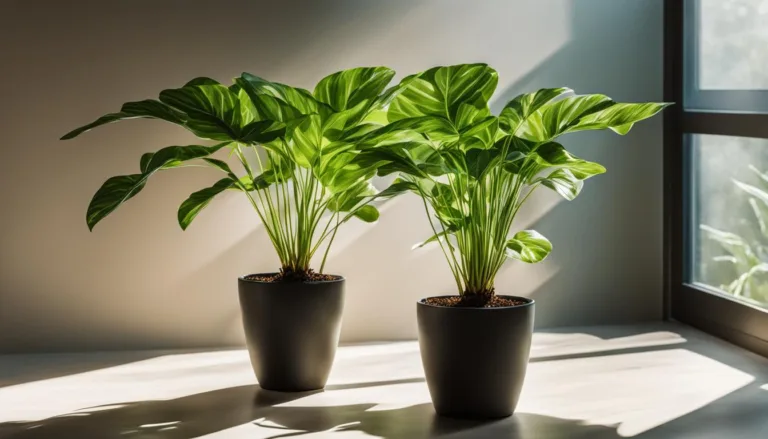
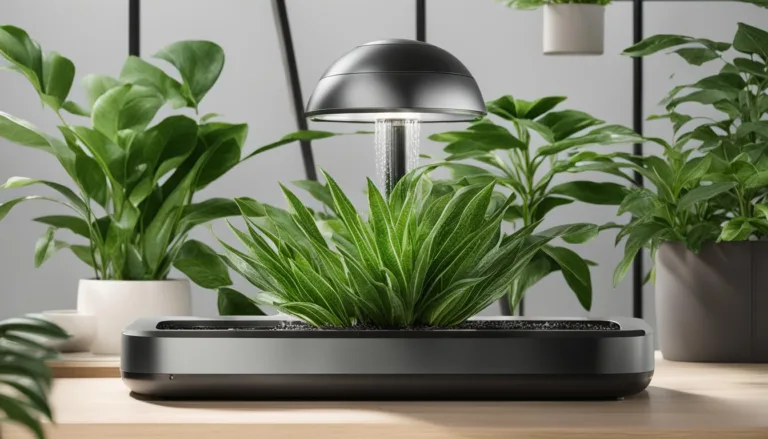
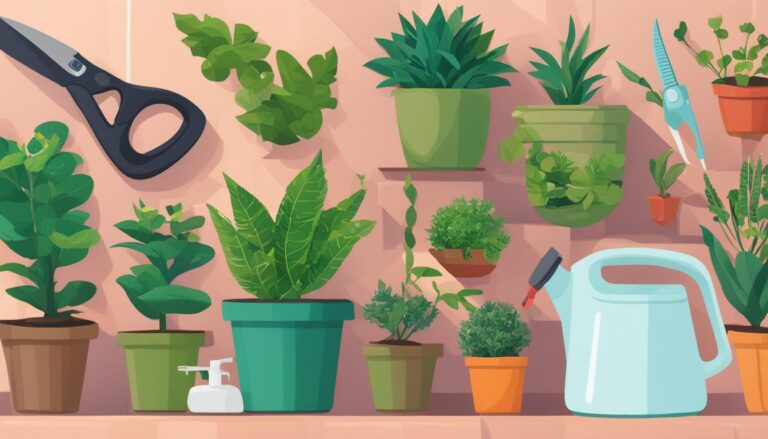
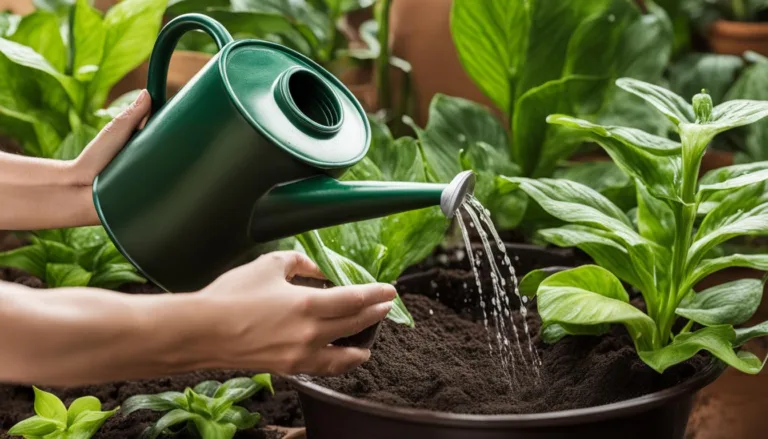
6 Comments
Comments are closed.